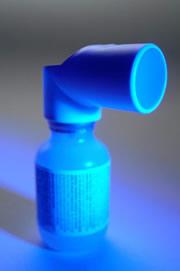 Inhalers with added proteins could stop a common cold from causing severe attacks.Getty
Inhalers with added proteins could stop a common cold from causing severe attacks.GettyNo one likes a cold, but the virus is especially dangerous for asthma sufferers, in whom it can trigger severe asthma attacks. Now research published in Nature Medicine1 shows that asthmatics' low levels of particular antiviral proteins are to blame. The finding suggests a new way to treat virus-induced acute asthma attacks: let the patient inhale the relevant proteins.
One in twelve people in the United Kingdom are currently treated for asthma. Their airways can become constricted and inflamed, making it hard to breathe. But day-to-day asthma is fairly well controlled by inhalers that open up the airways, says research leader Sebastian Johnston of Imperial College London, with the Medical Research Council's asthma mechanisms centre. The real problem is a severe asthma attack, triggered by allergens, exercise and viruses such as the common cold.
"For people with asthma, even a common cold can result in hospital treatment," says Lyn Smurthwaite of Asthma UK. Patients are normally given steroids, which dampen down inflammation but don't deal with the cold virus.
Johnston's team had discovered in 2005 that asthmatics' lung cells couldn't cope with cold viruses and didn't produce enough of a certain type of antiviral protein called beta interferons2. They then wanted to take a closer look at a newly identified family of these proteins, called lambda interferons, to see whether asthmatics also produce fewer of this variety. These proteins have recently been found to fight the cold virus by upping levels of other antiviral proteins and, if necessary, by killing cells containing the virus.
The team first took lung cells from volunteers and challenged the cells with the cold virus in a Petri dish. The number of lambda interferon proteins created by asthmatic patient cells was, on average, just half that of non-asthmatic volunteers.
The volunteers were then given a cold by intentional infection. The fewer lambda interferons their lung cells had produced in lab tests, the more severe the resulting asthma attack in the unfortunate patient.
Unclear cause
"These new lambda interferons, which would tackle the infection, were not being produced as efficiently in people with asthma," says Johnston. Why this should be, the team have no idea. It's not clear whether lack of interferons is a cause of asthma, or simply a symptom of the disease.
One hypothesis is that asthma sufferers haven't built up a fully working immune system (including interferons) — perhaps because they haven't been exposed to enough infectious diseases in their youth. "Or perhaps," suggests Johnston, "people with asthma have genetic defects in molecules that induce interferons."
ADVERTISEMENT
Whatever the reason, the team's discovery suggests a new way of treating severe, virus-associated asthma attacks. "The idea would be to deliver the interferon proteins by an aerosol to the respiratory tract," says Johnston. They haven't tested this idea with asthmatic patients yet, however — they are just beginning phase I safety trials of the idea.
Co-author Stephen Holgate, of the University of Southampton, UK, stresses the importance of looking for new asthma drugs. "The last 50 years have seen little new for the treatment of asthma, apart from improvements in beta agonists and inhaled steroids," he says.
He suggests that for too long, researchers and industry have studied agents that block asthma-like responses to allergens in animals. These don't always work so well in the clinic. "We need a different approach to make progress — starting with the human disease and studying cells from the airways of diseased individuals. Maybe the interferon story is one example of this."
Visit our treatmentmaytacklevirus.html">newsblog to read and post comments about this story.
